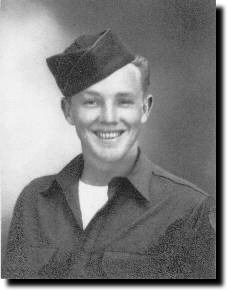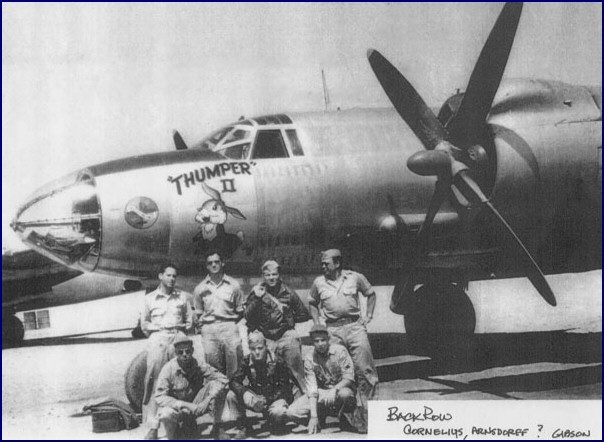![]()
Wud-e-ya
Know, If it isn't Bill Phillips
by
Gabriel R. McClure, 441st Bomb Squadron
|
|||||
|
|
One day, in Sardinia, while doing the preflight inspection on Thumper No. 2, I looked down to the ground and saw the armory group loading the bombs and installing all of the ammunition into the airplane. The armory people were not in the USAAF, but were a separate unit all to themselves. I had never paid much attention to them for as long as I had been in the 320th, we were so busy maintaining the aircraft that you didn't have much time to fraternize with others. Something drew my attention to the back of the head of one of these fellows. I could not take my eyes off of him. While I was looking at him he turned his head and to my unbelievable surprise it was Sgt. Bill Phillips, who as a boy I had known in Gainesville, Georgia since I was four years old. When he saw me he almost fainted. What was so unusual to me about
this incident was that we both had started from one point on the globe, our home
town Gainesville, Georgia, and traveled in two completely different paths and
ended up at one point on this world and on the same airplane on the Isle of
Sardinia at the same time. I guess we had both had been doing our job with the
aircraft for months and had not recognized each other. Very
unusual. |
||||
|
|
After this, the engines were shut down and visual inspections of the general aircraft were performed. This sounds like a small thing to do before a vital important mission but one must realize that much of the work was done the day before when your plane came in from yesterdays flight. As the Groups were returning from a bomb mission we always counted the planes as they approached the runway so as to know if we had lost any during the raid. If they got a direct hit on the target they would always shoot a certain color flair as they approached, and another color if they didn't drop and salvaged their bombs in the ocean. When we had guided our plane into it's parking space the crews got out and told us if anything unusual had happened. Inspections began immediately. First we checked the overall exterior of the plane for any flack damage. Then we checked the inside and all controls and the inside of the plane. We then cleaned the outside where oil had leaked. Hopefully by this time the oil and gasoline trucks had arrived and we filled the tanks and checked and filled the oil sumps. All work and servicing performed had to be entered into a report form. Because of the number of planes being serviced, we sometimes had to stay with the plane until ten or eleven o'clock at night before the service people could get to us. We could never leave the plane until it was serviced i.e. gasoline and oil. If the plane could not be ready for a mission the next day we had to mark the preflight form as grounded. I was only a PFC in rank, but if I grounded the plane because I found something wrong with it General Eisenhour could not release it until I signed the form that it was o.k. After this we could go back to back to the tent, clean up and eat a bite and go to bed and try to get a little sleep before the mission preparation the next day. When things were normal we did have one day a week off to do things like laundry, cleaning up tent,and other personal things and maybe go to town. When we bombed inland France during the Southern France invasion, one crew would fly a mission, return to base and after we checked and refueled the plane another crew would fly another mission. This was known as "around the clock" missions. One little thing of interest: Our winter uniform known as OD's were made of 100 % wool If you cleaned them with soap and water they would shrink drastically. The American Soldier , in WW II could improvise anything. We took a can with approximately a gallon of 100 octane airplane gasoline and washed the wool uniform in this. It would dry out completely on a clothe line and be as clean as a pen. We then burned the gasoline in our stove that heated the tent. |

Copyright(c) 2003. 320th History Preservation. All rights reserved.



















 Wud-e-ya Know, If it isn't Bill Phillips
Wud-e-ya Know, If it isn't Bill Phillips
